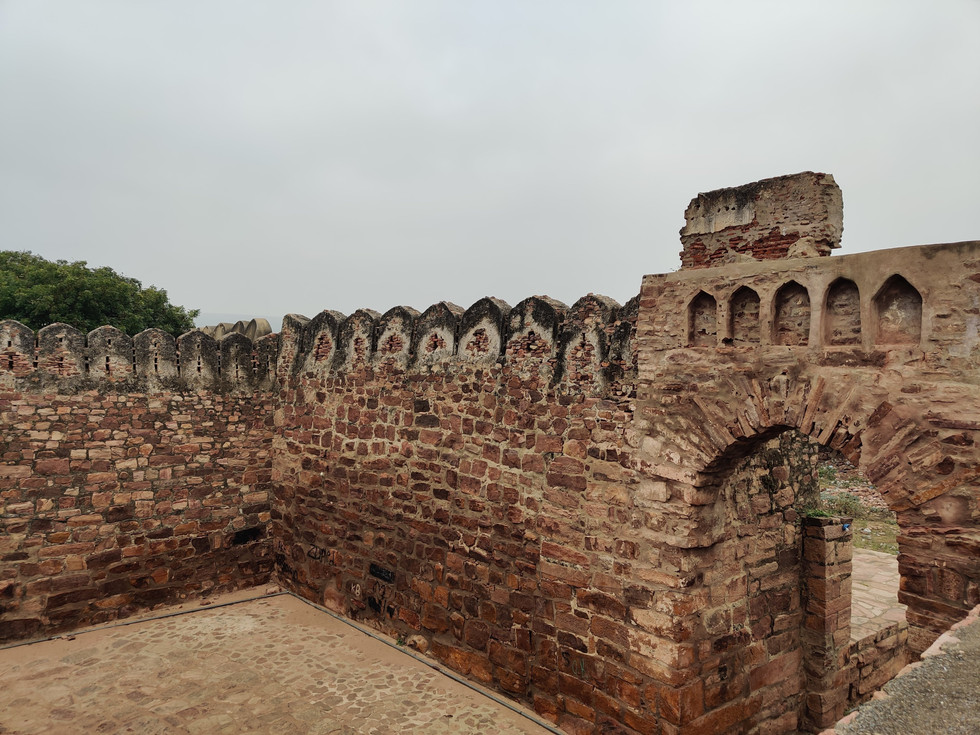The Crimson Canyon: Gandikota, the Ancient Fort City
- Sai Venkatesh Vemuri
- Jan 14, 2024
- 4 min read
Updated: Nov 12, 2024
Gandikota, often hailed as the Grand Canyon of India, is a captivating fusion of forces of nature and pages of history

Table of Contents
Nestled on the banks of the Penna River within the Kadapa district of Andhra Pradesh, Gandikota is celebrated for its breathtaking gorge, carved by the river through the Erramala Hills. Positioned at the heart of a triangle created by the cities of Hyderabad, Bangalore, and Chennai, Gandikota is approximately a 6-8 hour drive from each of these urban centers.
Canyon
The sunrise experience is undeniably a highlight of the visit. As dawn unfolds, the fort entrance buzzes with eager visitors making their way to the prime viewpoint, perfectly positioned for the breathtaking sunrise. A delightful 15-minute stroll leads you to this vantage point, where individuals get comfortable on the boulders, eagerly awaiting the sun's ascent. To secure the best spot, it's advisable to arrive early and enjoy the peace.


Ranganatha Swamy Temple
Nestled beside the viewpoint, the Ranganatha Swamy Temple stands in ruins, revealing echoes of its ancient glory. Though weathered, the main mandapam and pillars bear witness to the architectural splendour. You can see some of the beautiful carvings adorning the pillars and walls. From this vantage point, you can view nearby landmarks such as the Granary, Juma Masjid and Madhavaraya Temple.
Juma Masjid
Just a stone's throw away from the Ranganatha Swamy Temple stands the Juma Masjid. Like many traditional mosques, it has arched doorways, spacious courtyard and ornate minarets. Unfortunately, during the time of our visit, the mosque was closed, preventing us capturing the details inside.
Madhavaraya Temple
The Madhavaraya Temple stands out as the most breathtaking edifice within the fort complex. Its tranquil ambience captured my heart. Remarkably well-preserved, the temple exudes a vibe reminiscent of Hampi, transporting you back to the splendid era of the Vijayanagara period.
Fort and other structures within the complex
The basic fort was established in 12th century by the Kapa rulers and came under influence of diverse regimes, including the Kakatiya, Vijayanagara, and Golconda Sultanate. Each of them contributed to the fort complex by adding new structures or ehancing existing fortification. The fort walls stretch for several kilometres and certain sections still reveal remnants of the ancient moat.
Below are some of the other noteworthy structures nestled within these ancient walls.



Presented below are the works of Thomas Fraser showcasing majestic fortress and surrounding landscapes of Gandikota. Contemplating these masterpieces, one can imagine the once-mighty and impregnable nature of this fortress.


The once formidable fortress is displaying noticeable damage due to the forces of nature and human activity. Here's to hoping for aggressive restoration efforts and responsible tourism to preserve this invaluable heritage that we cannot afford to lose.
Belum Caves
Situated just 65 kilometers away from Gandikota lies India's second-largest natural cave system, the Belum Caves. This expansive underground marvel spans 3 kilometres and has 46 meters below ground at its deepest point.


The caves consist predominantly of limestone, shaped over thousands of years by the continuous flow of water. The intricate patterns created by water eroding the rocks, as well as the gradual formation of stalactites and stalagmites, are clearly visible throughout the expanse.
The cave is segmented into various sections, each bearing names based on the distinctive (in some cases vague) resemblance to real world objects, including the Meditation Room, Thousand Hoods, Mandapam, Banyan Tree Hall, and others.
One aspect that didn't appeal to me was the use of colourful lights inside, as I believe it somewhat diminishes the authentic ambience of the place. Opting for classic warm lights might have provided a more genuine experience.
The excavation revealed numerous Buddhist and Jain relics, imparting historical significance to the site. Consequently, a 40-foot-tall statue of Buddha was erected at this location.

Navigating the cave system involves a substantial amount of walking, and some sections are not easily accessible. Although fresh air is continuously pumped in from above, be ready for minor discomfort at times.
Owk Reservoir
Approximately 15 kilometers from Belum Caves lies Owk Reservoir, where we were treated to a breathtaking sunset. And to top it off, we also prepared a plate of Maggi and allowed ourselves to absorb the beauty of the nature all around.

And that wraps up this journey! Be sure to explore more stories on this blog. I'd love to hear from you, so feel free to connect through the contact section.
Essential Information
Who should visit?
Nature Lover
Weekender
Budget Explorer
Architecture Buff
When to visit?
NOT summers
Recommended -September to February
Where to Stay?
Haritha Resort by APTDC, Goverment of Andhra Pradesh
Note: Camping tents are NOT allowed anymore due to the disturbances and mess being created at the camp sites.
Make reservations well in advance. There are very limited options during the peak season.
What to do?
Sunrise and/or sunset from view point inside Gandikota Fort.
Explore Gandikota Fort Complex and do not miss
Ranganathy Swamy Temple
Madhavaraya Temple
Juma Masjid
Boating in the Penna river
How to travel?
Nearest Major City: Kadapa ~90kms
Nearest Town: Jammalamadugu ~15kms
Bus can be taken from Kadapa to Jammalamadugu, and an auto from there to Gandikota
Recommended Trip Duration
2 Days / 1 Night*
Estimated Trip Budget
~INR 5,000 per Person*
* Excluding transportation costs via flight or train, and if you'll be traveling around via public transport or in a group of four using a car.
_PNG.png)

















































Comments